After collecting, restoring, and reproducing numerous old locomotives and rail cars for the railroad’s 1927 centennial, and then showing off many of the items in that collection at various fairs in the 1930s and 1940s, the B&O decided to open a full-fledged railroad museum in 1953. This booklet is the program for the dedication of that museum.
 Click image to download a 4.3-MB PDF of this 8-page booklet.
Click image to download a 4.3-MB PDF of this 8-page booklet.
The “first stone” for the railroad had been laid on July 4, 1827. The B&O reenacted that ceremony for the dedication of its museum. Perhaps to avoid other Fourth of July celebrations, this took place on July 2, 1953. The program lists the names of people giving speeches at the ceremony, including Maryland Governor Theodore McKeldin and B&O president Roy White. But it also provides the complete script of the reenactment of the laying of the first stone–a reenactment that had obviously been highly dramatized.
You will see the list of options and you need to icks.org buy generic cialis choose one of them. It could be levitra 60 mg surprising to read that only 20% of total ED patients take a medication, while other remain undiagnosed. Overview of Western literature Allergic rhinitis is one manifestation of allergy that occurs around the nose, with signs and symptoms include: Sneezing, wheezing, especially when I wake up in generic india viagra http://www.icks.org/data/ijks/1482456658_add_file_1.pdf the morning A runny nose with clear runny nose or nasal congestion Nose and throat from entering the middle ears. The generic version of this medicine is cialis pills “Sildenafil Citrate”. “New York merchants are getting rich off trade from the West–trade that should rightfully be ours,” says one actor. “Something must be done, or we’re lost!” responds another.
Construction of the B&O didn’t prevent New York from remaining ascendent over its eastern neighbors, and the B&O’s status reflected that: at best, it was a third-rank railroad behind the mighty Pennsylvania and the arrogant New York Central. In 1830, Baltimore was the nation’s second-largest city, less than half the size of New York but slightly larger than Philadelphia (which, however, had larger suburbs that would soon be incorporated into the city). By 1953, Baltimore was still the nation’s sixth-largest city, behind New York, Chicago, Philadelphia, Los Angeles, and Detroit.
Today, Baltimore is the nation’s twenty-sixth-largest city, having been overtaken by numerous cities in the South and West. But what may hurt the most is that it has also been overtaken by Boston, Washington, Charlotte, and Jacksonville, making it, at best, the seventh-largest city east of the Appalachians. When measured as urban areas, Baltimore is ranked nineteenth, but is still led by New York, Philadelphia, Miami, Washington, Boston, and Tampa east of the Appalachians.
The B&O Railroad undoubtedly greatly contributed to commerce in Baltimore, but didn’t prevent it from slipping well behind some of its peers. However, the B&O museum is still open and is a wonderful place to visit.

Unfortunately for the B&O, their territory began to lose both population and business from about the mid-50’s on. That’s the time I was old enough to really understand what was happening and, even though it wasn’t all that apparent, the rot had already begun to set in. Baltimore, Cleveland, Detroit…all the big industrial cities began their long downward spiral. At least Baltimore retains some of its importance as a major seaport. Cleveland, my home town, only has shuttered and vandalized factories and abandoned port facilities. Baltimore went from 949,000 in 1950 to 620,000 in 2010. for those same years, Cleveland skidded from 914,000 to 390,000, and it’s still going down. During those same years, railroads went from important institutions to just freight haulers. How could we even have something like the B&O museum dedicated today? The B&O was submerged into what became the CSX, a railroad where the name was deliberately chosen because it has no meaning. I can’t even imagine a “CSX Museum”. Just as railroads have become insignificant in the public’s mind, so have the great industrial centers they serve…or used to serve.
Jim